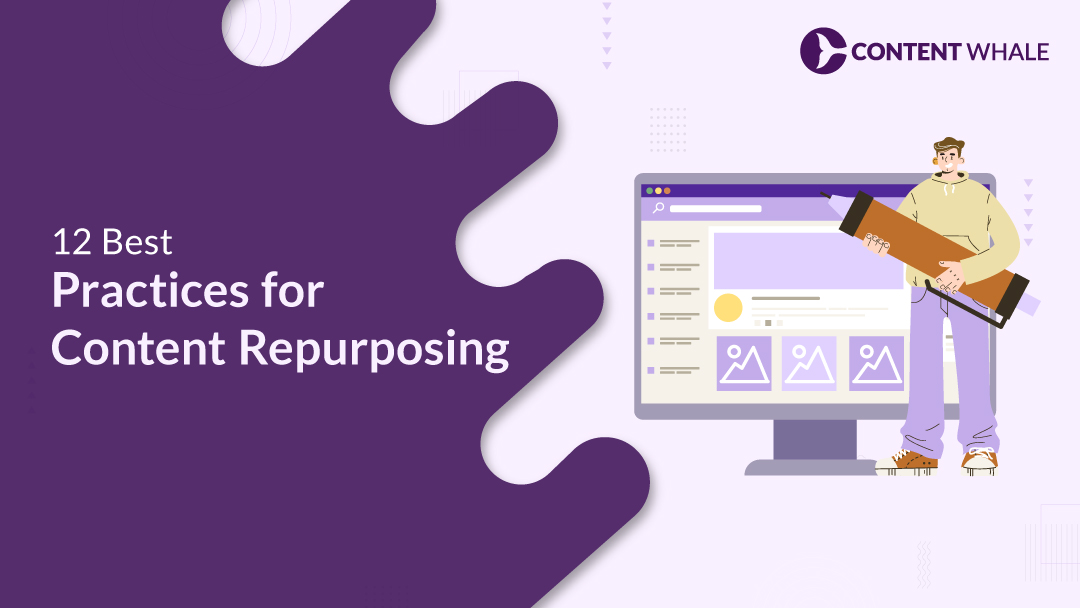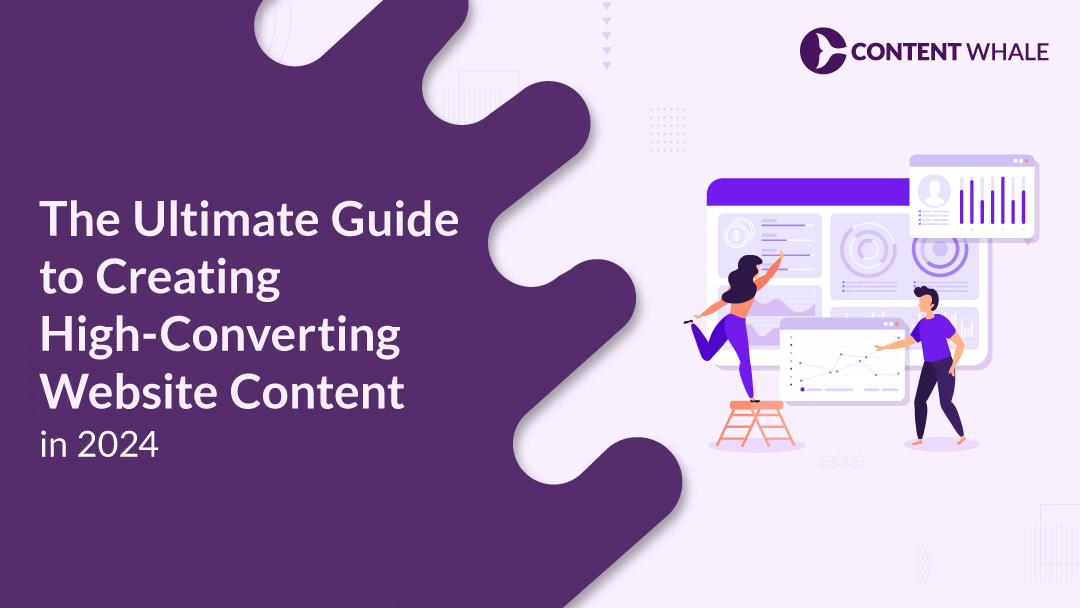Quick Summary
- Learn the importance of content repurposing for content marketing.
- Discover 12 actionable best practices for repurposing content.
- Understand how to tailor content for different platforms.
- Explore ways to measure the success of repurposed content.
- Find out how Content Whale can help with professional content repurposing.
This summary provides a brief overview of what you’ll learn in this guide, highlighting the benefits and strategies for repurposing your content to enhance your content strategy and improve your SEO content efforts. Let’s start, shall we?
Content repurposing is the process of transforming existing content into new formats to extend its reach and lifespan. This practice is integral to a robust content marketing strategy, offering numerous benefits such as increased engagement, improved SEO, and cost efficiency. By repurposing your content, you can maximize the value of your existing assets, saving time and resources while maintaining a consistent content output.
This guide introduces 12 best practices for effective content repurposing. These strategies will help you adapt your content for different platforms, create engaging visuals, and reach a broader audience. From turning blog posts into podcasts to leveraging user-generated content, you’ll discover actionable tips to enhance your content strategy. Understanding and implementing these practices can significantly boost your digital marketing efforts, ensuring that your content remains relevant and impactful across various channels.
1. Identify High-Performing Content
Finding and leveraging high-performing content is essential for effective content repurposing. Here’s how you can do it:
- Analyze Performance Metrics: Use tools like Google Analytics, Ahrefs, and SEMrush to track key metrics such as page views, engagement rates, and social shares.
- Focus on Engagement: Identify content that has consistently attracted attention and engagement from your audience.
- Select Top Performers: Prioritize content that aligns with your content strategy and has proven effective in driving SEO content and audience interaction.
By identifying these top performers, you can ensure that your efforts to repurpose content will yield the best results, enhancing your overall content marketing and digital marketing strategies.
2. Tailor Content for Different Platforms

Creating platform-specific content is key for effective content repurposing. Each social media platform has its unique audience and content style. For example:
Instagram:
- Focus on high-quality visuals. Use engaging photos, short videos, and infographics.
- Leverage Stories for more interactive and time-sensitive content.
LinkedIn:
- Share professional and informative content, such as industry insights and company updates.
Twitter:
- Keep posts concise and timely. Use hashtags strategically to increase reach.
Facebook:
- Utilize a mix of videos, images, and longer text posts to engage users.
By adapting your content to fit each platform’s requirements, you can enhance your content marketing and digital marketing strategies, improving overall content strategy and SEO content efforts.
3. Create Visual Content from Text
Transforming text into visual content can significantly boost engagement and retention. Visuals such as infographics, videos, and images make complex information more digestible and appealing.
Benefits of Visual Content:
- Increased Engagement: Visuals grab attention and encourage interaction, crucial for digital marketing.
- Enhanced Understanding: Infographics and charts simplify complex data, making it easier for your audience to comprehend.
- Improved Retention: People remember visuals better than text, enhancing the effectiveness of your content marketing efforts.
Tools for Creating Visual Content:
- Canva: Ideal for designing infographics and social media graphics.
- Piktochart: Perfect for creating professional presentations and infographics.
- Animoto: Useful for turning blog posts into engaging videos.
Incorporating visual content into your content strategy not only enhances your SEO content but also amplifies the reach and impact of your repurposing content initiatives.
4. Turn Blog Posts into Podcasts

Converting blog posts into podcasts is an effective way to reach new audiences and enhance your content marketing efforts. Here’s how to do it:
- Select High-Performing Posts: Choose blog posts that have resonated well with your audience.
- Convert to a Script: Transform the blog content into a conversational script.
- Record the Podcast: Use a good-quality microphone and a quiet environment for clear audio.
- Edit the Recording: Trim any errors and consider adding background music for a professional touch.
- Publish and Promote: Use platforms like Anchor or Buzzsprout to distribute your podcast.
Repurposing content this way can significantly boost your content strategy and digital marketing impact, making your SEO content more diverse and accessible.
5. Develop E-books from Blog Series
Creating e-books from a series of blog posts is a strategic way to repurpose your existing content and expand your content marketing efforts. Here’s how to do it:
- Compile Related Posts: Select a series of related blog posts that cover different aspects of a single topic.
- Organize and Format: Create a clear structure, dividing the content into chapters or sections. Use tools like Visme or Canva to design and format your e-book professionally.
- Add Visuals and Links: Enhance your e-book with relevant images, infographics, and embedded links to improve engagement and provide additional resources.
- Promote and Distribute: Use platforms like Amazon Kindle Direct Publishing or your own website to distribute your e-book. Promote it via social media, email newsletters, and your blog.
By transforming blog series into e-books, you can provide valuable, long-form content to your audience, enhancing your content strategy and boosting your SEO content.
6. Leverage User-Generated Content

Utilizing user-generated content (UGC) is a powerful strategy for content repurposing. It enhances authenticity, builds community, and increases engagement. Here’s how to leverage UGC effectively:
- Encourage Participation: Launch hashtag campaigns and contests to motivate users to share their experiences and content.
- Highlight Reviews and Testimonials: Showcase user reviews on your website and social media to build trust and credibility.
- Feature User Content: Share user-generated photos, videos, and stories across your platforms to create a sense of community.
By incorporating UGC into your content marketing and content strategy, you enhance your brand’s authenticity and engagement, making your SEO content more dynamic and relatable.
7. Repurpose Webinars and Presentations
Repurposing webinars and presentations is a smart way to extend the life of your content and reach new audiences. Here’s how to do it:
- Create Short Video Clips: Break down the webinar into short, engaging clips. Share these on social media and your website to attract more viewers.
- Turn Q&A into Blog Posts: Use the questions and answers from your webinar to create insightful blog posts. This content can address common queries and drive traffic.
- Develop Infographics: Convert key data and insights from your webinar into visually appealing infographics.
- Generate Podcasts: Transform the audio from your webinars into podcasts to reach audiences who prefer listening over watching.
Repurposing your webinar content can boost your content marketing efforts, enhance your content strategy, and improve your SEO content by providing diverse, valuable content across multiple platforms.
8. Use Social Media Snippets

Social media snippets are a great way to maximize your content repurposing efforts and keep your audience engaged across different platforms. Here’s how you can effectively use them:
- Create Bite-Sized Content: Break down long-form content into short, engaging snippets. Use key points from blog posts, videos, or webinars to create impactful social media posts.
- Visual Appeal: Enhance snippets with visuals like infographics, quote cards, or short video clips to capture attention quickly.
- Platform-Specific Formats: Tailor content to fit the unique requirements of each social platform, such as Instagram Reels, Twitter threads, or LinkedIn articles.
By repurposing content into social media snippets, you can boost your content marketing and digital marketing strategies, improving SEO content and maintaining a consistent presence across various channels.
9. Refresh and Update Old Content
Refreshing and updating old content is a key practice in effective content repurposing. Here’s how to do it:
- Update Outdated Information: Refresh statistics, examples, and links to ensure they are current and relevant. Replace old data with the latest findings to keep the content accurate and valuable.
- Optimize for SEO: Use tools like Ahrefs or SEMrush to identify new keywords. Update meta descriptions, title tags, and headers to improve search engine rankings.
- Enhance Visuals and Format: Add new images, infographics, or videos to make the content more engaging. Break up text with headings and bullet points for better readability.
By keeping your content up-to-date, you improve its performance in SEO content and maintain its relevance in your content marketing and digital marketing strategies.
10. Syndicate Content to Other Platforms

Syndicating your content to other platforms can significantly enhance your reach and visibility. Here’s how to do it effectively:
Choose the Right Platforms:
Platforms like LinkedIn, Medium, and Quora are excellent for republishing articles. These platforms have vast audiences and can drive substantial traffic back to your site.
Use Paid Syndication:
Services like Outbrain and Taboola can help you reach even larger audiences by placing your content on high-traffic websites. This can be particularly effective for content marketing campaigns.
Optimize for SEO:
Ensure you use canonical tags to avoid duplicate content issues and retain SEO value. This helps search engines recognize the original source of your content, boosting your SEO content strategy.
Syndicating content effectively can amplify your content strategy and improve your digital marketing efforts, making your content accessible to a broader audience.
11. Create Case Studies from Customer Stories
Turning customer success stories into case studies is a powerful method of content repurposing. Here’s how you can do it effectively:
Identify Key Customers:
Choose customers who have achieved notable success with your product. This highlights the impact of your solution in real-world scenarios.
Structure the Story:
Start with the customer’s problem, explain how your product provided a solution, and conclude with the results. Use data and visuals to make the story more compelling.
Leverage Multiple Formats:
Publish the case study as a blog post, include it in webinars, and share snippets on social media. Video testimonials can also enhance credibility and engagement.
Repurposing these stories enhances your content marketing and content strategy, making your SEO content richer and more relatable for your audience.
12. Monitor and Measure Success

Monitoring and measuring the success of your repurposed content is essential to ensure your content strategy is effective. Here’s how to do it:
Define Key Performance Indicators (KPIs):
Identify relevant metrics such as engagement rates, organic traffic, conversions, and social shares. Tailor these KPIs to the specific goals of your content marketing and digital marketing efforts.
Use Analytics Tools:
Employ tools like Google Analytics, SEMrush, and social media insights to track performance. Monitor metrics like page views, time on page, and bounce rates to assess the effectiveness of your SEO content.
Gather Feedback:
Collect audience feedback through comments, surveys, and direct interactions to understand how your repurposed content is received and where improvements can be made.
By consistently evaluating these metrics, you can refine your content repurposing strategies, ensuring your content remains impactful and aligned with your marketing goals.
Conclusion
Content repurposing is a powerful strategy for any effective content strategy. By transforming existing content into new formats, you can significantly extend its reach and lifespan, maximizing the value of your content marketing efforts. This approach not only saves time and resources but also ensures consistent engagement across various platforms. Whether it’s turning a blog post into a podcast, creating infographics from articles, or updating old content with fresh insights, repurposing enhances your SEO content and broadens your audience.
At Content Whale, we specialize in creating and repurposing high-quality content tailored to your business needs. Our team can help you develop a strategic plan to repurpose your content effectively, ensuring it remains relevant and impactful. Ready to take your digital marketing to the next level? Contact Content Whale today and let us help you make the most of your content assets, driving better engagement and higher ROI.
FAQs
1. What is content repurposing and why is it important?
Content repurposing is the process of taking existing content and transforming it into different formats to reach a wider audience and extend its lifespan. It’s important because it maximizes the value of your content, saves time and resources, and ensures consistent engagement across various platforms. This approach enhances your content marketing and improves SEO content by diversifying content formats and distribution channels.
2. How can I identify which content to repurpose?
Identify high-performing content using analytics tools like Google Analytics and SEMrush. Focus on content with high engagement, traffic, and social shares. This content is more likely to succeed when repurposed, supporting your content strategy and boosting your digital marketing efforts.
3. What are some tools for creating visual content from text?
Tools like Canva, Piktochart, and Visme are excellent for converting text into engaging visuals. These tools help create infographics, presentations, and social media graphics, making your content more shareable and improving your SEO content.
4. How do I measure the success of my repurposed content?
Use metrics like engagement rates, website traffic, and conversions to measure success. Tools like Google Analytics, social media insights, and other analytics platforms can track these metrics, helping you refine your content strategy and improve your digital marketing performance.
5. Why should I consider using professional content repurposing services?
Professional services offer expertise and resources to effectively repurpose content, ensuring high quality and consistency. They can help you develop a strategic plan, save time, and achieve better results in your content marketing and digital marketing campaigns.





